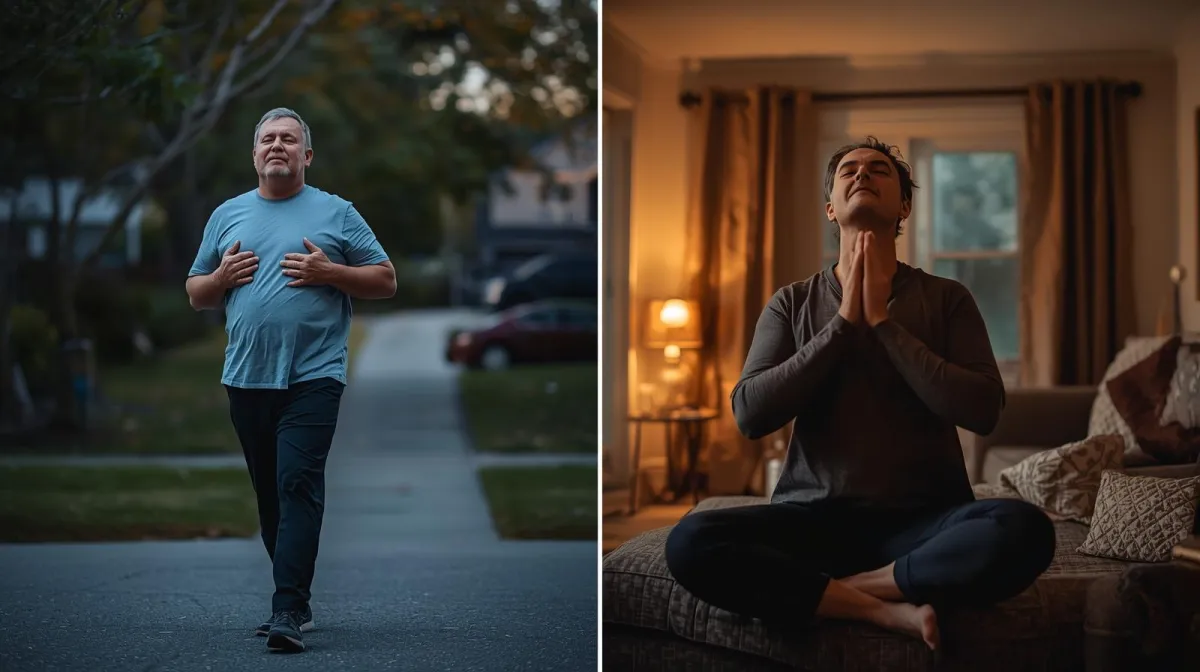
Tiny Habits That Lower Blood Sugar Fast
Move, Breathe, Repeat: Tiny Habits That Lower Blood Sugar Fast
If your schedule is full and your energy is uneven, the best plan is the simplest plan. You don’t need an hour at the gym to help your blood sugar. Short walks after meals, a handful of strength moves, and a few calm breaths at night can create steady energy you can feel in a week.
Education only—not medical advice. If you use insulin or medicines that can cause low blood sugar, talk with your healthcare provider before changing activity.
Why Short Movement Works (Muscle + Glucose 101)
Your muscles use sugar (glucose) for fuel. When they contract, they pull glucose out of your blood and into the muscle cells. This happens during a walk, climbing stairs, doing wall push-ups—any movement counts. Here’s what makes it powerful:
Fast benefit: A 10-minute walk after a meal can flatten a spike because the working muscles use glucose while food is being digested.
Insulin-independent pathway: Muscle contraction helps move glucose into cells even without extra insulin. That’s great news if insulin resistance is part of your picture.
More muscle = better sensitivity: Simple strength work builds or maintains muscle, which helps your body handle glucose better all day long.
Lower stress: Gentle movement and slow breathing calm your nervous system, which can also help steady blood sugar.
Bottom line: small, frequent movement is like a steady drip of benefits.
The 10-10-10 Method (Walks, Strength Basics, Breaths)
This is your busy-day framework. Pick one, two, or all three. Consistency beats intensity.
1) 10 minutes of walking (1–3×/day)
Best timing: within 10–30 minutes after meals.
Indoors? Walk hallways, march in place, climb stairs.
Outside? Stroll your block; set a 10-minute timer.
2) 10 body-weight moves (total 5–10 minutes)
Do 30–60 seconds each. Pick 6–10 from this list and keep it light:
Squats or sit-to-stands (use a chair)
Wall push-ups (hands at chest height)
Glute bridges (on back, feet flat)
Counter rows (hold a sturdy counter, lean back slightly, pull chest forward)
Marching in place (knees up, gentle pace)
Mini lunges (hold a chair for balance)
3) 10 calm breaths before bed
Inhale 4 seconds → hold 2→ exhale 6.
Repeat for 10 breaths (about 2–3 minutes).
Lights dim, phone away. This helps you fall asleep faster and sleep deeper—the kind of sleep that supports steady glucose tomorrow.
Quick combo tonight: 10-minute after-dinner walk → 5 body-weight moves (30–45 sec each) → 10 slow breaths in bed.
Beginner Strength Mini-Circuit (No Equipment)
Time: 8–12 minutes. Format: 30–45 seconds per move, minimal rest, repeat 1–3 rounds.
Sit-to-stand from a chair
Wall push-ups
Glute bridges
Standing calf raises
Bird dog(slow and controlled)
Make it easier:
Reduce time to 20–30 seconds.
Use a higher chair or a countertop for push-ups.
Hold onto the chair for balance on calf raises.
Make it stronger:
Increase to 45–60 seconds per move.
Add a second or third round.
Slow the lowering phase (3 seconds down) for extra challenge.
Safety tips: Move within a pain-free range; breathe steadily; stop if you feel dizzy, short of breath, or unwell.
Desk Day Plan + Travel Swaps
On heavy computer days:
Movement snack every hour (1–2 minutes):
10 chair squats • 10 wall push-ups • 20-second calf raises
Lunch walk: 10 minutes right after eating.
Hydration cue: Every time you refill your water, do 30 seconds of marching in place.
When traveling:
Airport: Walk the concourse for 10 minutes before boarding.
Hotel room: 5-minute circuit—chair squats, wall push-ups, glute bridges, calf raises, march in place.
Restaurant: After the meal, walk the block once before driving back.
If it rains:
March in place during a favorite song.
Climb stairs for 5 minutes total (easy pace).
Hallway loops with a 10-minute timer.
Habit Stacking & Tracking (How to Be Consistent)
Keep it friction-free:
Shoes by the door after dinner = walk trigger.
Chair in open space = sit-to-stand reminder.
Phone reminder labeled “10-10-10” at the time you usually finish dinner.
Stack with daily anchors:
After brushing teeth at night → 10 slow breaths.
After you finish a meal → 10-minute walk.
After closing your laptop → 5 strength moves.
Troubleshooting:
Too tired at night? Do your 10 breaths earlier in the wind-down.
Forgot to walk after dinner? Take a 10-minute lap while the tea kettle boils.
Sore knees? Swap squats for sit-to-stands and mini lunges for marching in place.
Action Steps
Tonight:
Walk10 minutes after dinner.
Do 5 body-weight moves (30–45 seconds each).
Take10 slow breaths in bed.
This week:
Repeat the 10-10-10 plan at least 4 days.
Screenshot the tracker and mark your wins.
Add a tiny reward on Sunday (a relaxing bath, a new pen, a nature walk).
Want support?
Join the Blood Sugar Reset Membership for weekly coaching, check-ins, and simple plans that fit your life. We’ll tailor the 10-10-10 to your schedule and troubleshoot together.
You don’t need perfection—just tiny actions, repeated. Move, breathe, repeat.
